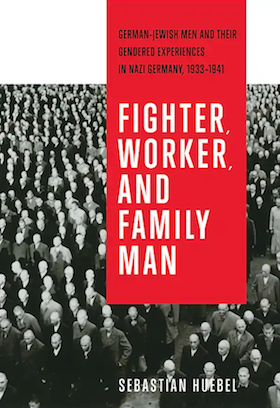As soon as they got into power, German Nazis began to make life hell for German-Jewish men – partly to promote their sadistically comic-book ideal of “Aryan” masculine supremacy, and partly out of a desire to plunder valuables and property. And also, it must be said, out of simple criminal/pathological malice.
 Fighter, Worker and Family Man: German-Jewish Men and Their Gendered Experiences in Nazi Germany, 1933-1941 (University of Toronto Press, 2022) is a thoroughly researched book. In it, Sebastian Huebel – a sessional instructor in the history department at University of the Fraser Valley – depicts various strategies used by the Nazis to isolate and degrade German-Jewish men in the years prior to the concentration camps. His metaphor for this program of debasement and humiliation is “emasculation,” and the word identifies the book’s focus: how the Jewish-German (heterosexual) male was shamed by the dispossession of any masculine identity as “fighters, workers or family men” – the traditional markers of masculinity in Europe in those days.
Fighter, Worker and Family Man: German-Jewish Men and Their Gendered Experiences in Nazi Germany, 1933-1941 (University of Toronto Press, 2022) is a thoroughly researched book. In it, Sebastian Huebel – a sessional instructor in the history department at University of the Fraser Valley – depicts various strategies used by the Nazis to isolate and degrade German-Jewish men in the years prior to the concentration camps. His metaphor for this program of debasement and humiliation is “emasculation,” and the word identifies the book’s focus: how the Jewish-German (heterosexual) male was shamed by the dispossession of any masculine identity as “fighters, workers or family men” – the traditional markers of masculinity in Europe in those days.
Gender is a rare focus in Holocaust literature and, when the topic of gender arises there, it is almost always about women, and written by feminist scholars, as Huebel notes.
But men’s victimization, as Huebel demonstrates, also deserves scrutiny. During the 1930s, the overwhelming percentage of camp internees were male (“cheats,” “traitors,” “greedy bankers,” “race defilers,” “manipulators of international capitalism,” etc.): in other words, women did not fit the Nazi stereotype of the gendered male Jewish fifth-column “enemy.”
The Jewish male “enemy” was uniformly forced out of work, his business expropriated; he was excluded from the military, and his military service in the First World War ignored. In public, he was ridiculed, he was caricatured in propaganda and openly derided – all, as mentioned, to further the absurd Nazi fantasy of the “Aryan” übermensch. For what reason? Simply to “justify the need for protecting Germany from within” by inventing a supposed internal threat – to this day, a tried-and-true strategy practised by would-be and extant dictators.
(It’s worth noting that Huebel does not address the perceived threat emanating from the predominance of Jewish men in the German Communist and Social Democratic parties, in labour unions, and among other dissidents.)
In private, the Jewish father/husband paradigm crumbled under the weight of Nazi deprecation. With no work, no “bread being won,” the only way the Jewish father/husband could show his worth to the family was to arrange for emigration. But, as Holocaust historians have amply shown, by the time it was clear to the German Jews that the Nazis were not going to go away, the “free world” had closed its doors to them. (Canada’s famous response to the question of how many Jewish refugees should be admitted was “None is too many!”)
On a more positive note, Huebel notes that the at-home father model led to increased bonding – unusual for the time – between father and family, and Huebel offers lots of documentary evidence of signs of love and affection between the unemployed father and his children. As well, fathers frequently became at-home teachers to their expelled children – more evidence of “a new presence at home” that led to a reaffirmation of men’s role as father/mentor-educators.
On the streets, as Nazi violence against men increased, men were often coated with tar, made to walk barefoot over broken glass, made to stand for attention for long hours in bitter cold, and forced to open their mouths for Nazis to spit in. As a result, women were more and more often required to go out in public for menial chores.
The gender-specific treatment of men in the camps has not, Huebel says, been examined as closely as has been the treatment of women. To illustrate his point, he stresses how forced labour demanded of men, particularly in brickworks and quarries, led to disfigured bodies, “violated psyches” and premature death. Those who survived returned home like ghosts, permanently traumatized both physically and mentally, tortured by nightmares and often considering (and committing) suicide.
At no point in his book does Huebel denigrate the experiences of Jewish women under Nazism: “different horrors, same hell,” as Myra Goldenberg and Amy Shapiro said in the title of their excellent 2013 book.
Huebel’s oft-stated intention is to draw attention to the specific way men were abused, from beard-pulling to climbing up and down rock quarries until death. Jewish males were, as mentioned, typically regarded by Nazis as the “greater threat,” and were victimized accordingly.
Overall, Huebel shares the hope, in his conclusion, that a study of the erosion of Jewish male masculinity under Nazism can “sharpen our understanding of contemporary issues related to gender.”
This is a daunting objective, if not fulfilled, at least boldly addressed in this groundbreaking book.
Graham Forst, PhD, taught literature and philosophy at Capilano University until his retirement and now teaches in the continuing education department at Simon Fraser University. From 1975 to 2010, he co-chaired the symposium committee of the Vancouver Holocaust Education Centre.




